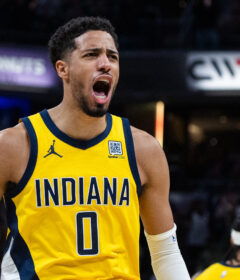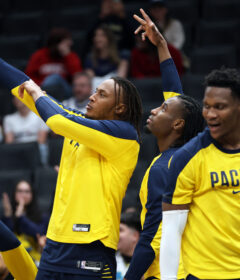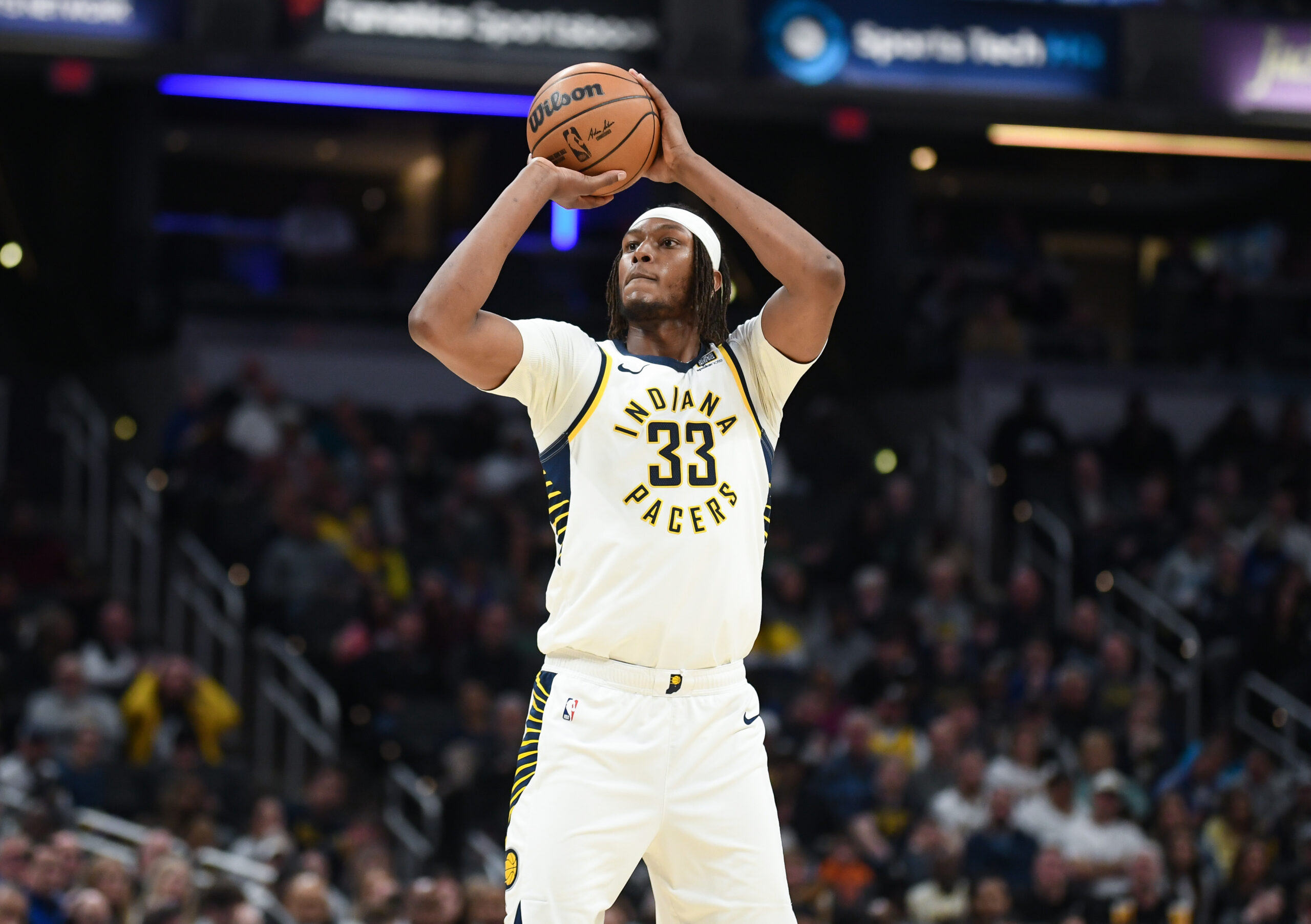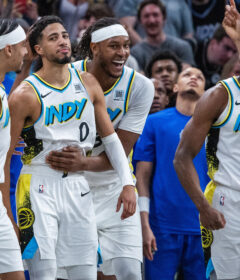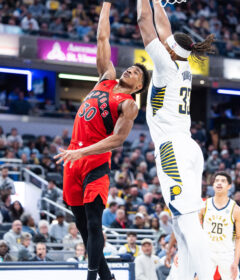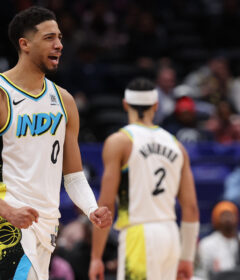ISL’s Chris Goff grades the Pacers’ offseason moves
By CHRIS GOFF
ISL Correspondent
Indiana’s offseason began, not at 12:01 a.m. on July 11, but shortly before 10 p.m. on May 24. That’s when Pacers coach Frank Vogel turned to his bench to close the third quarter in a must-win Game 6.
Down 68-66 to the Miami Heat with a mere 183 seconds on the clock, Leandro Barbosa entered the game on a dead ball. Within his first minute, on consecutive possessions, the midseason pickup committed a turnover and missed a 3. Then Darren Collison followed with a double dribble and later allowed the ball to be stolen by Mike Miller.
With reserves Barbosa, Collison and Tyler Hansbrough on the floor, the Pacers’ defense permitted Miami an 8-0 run to close the quarter, morphing a close score into a 10-point, season-ending hole. When the dust settled, Erik Spoelstra had used five bench players, who were a collective plus-39 in their 74 minutes. Indiana, by extreme contrast, lost a combined 73 points during the 41 minutes given to its five backups. Not surprisingly, the Pacers’ starters couldn’t compensate, and Indy’s season was over.
One envisions then-president Larry Bird, perched in his usual corner seat next to the tunnel to the Pacers’ locker room, thinking to himself, Never again. Gonna switch them bench guys out.
And Indiana did just that, among several other moves made in this nearly complete offseason.
The Pacers are pretty much done with their summer. The team has 13 players on the roster at the moment – if you include unsigned second-round draft pick Orlando Johnson — two less than the maximum but congruent with the league’s minimum.
With training camp weeks away, now is the time to assess all that’s happened since May.
Everyone relates to grades. Although subjective, they’re easy to understand. Pass the red pen, then, and let’s draw a B-minus atop the blue-and-gold’s offseason report card.
There are three main reasons to like what reinstalled team president Donnie Walsh did. First, he invested only in young players, not ones headed for a decline as they enter their mid-30s. Second, Walsh avoided the Landry Fields/Kwame Brown why-do-we-need-this-guy-again affliction. Each player Indiana resigned or acquired fills a team need and joins the roster with a defined role. Finally, the franchise did nothing to significantly hamper its position for the summer of 2014, when the Pacers must decide whether to continue with the present core or to start over and go in a different direction. In fact, the only Pacers scheduled to earn meaningful money past 2013 are Roy Hibbert and George Hill.
It was a busy summer. Indiana doled out $127.5 million in veteran contracts, easily the most since 2003, when the Pacers spent $163.7 million.
Did Indy go too far? Perhaps. Paying nearly $100 million for two players -Hibbert and Hill — who combined to average about 23 points per game last season means you probably overpaid. But contrast the Pacers’ moves with those of the Nets, who now willingly owe an astounding $274 million to Deron Williams, Joe Johnson, Brook Lopez and Kris Humphries.
Walsh avoided doing anything maniacally silly, like handing Jason Kidd a three-year contract, or signing Jamal Crawford for four seasons, or paying Fields close to $7 million a year. Sometimes not doing anything foolish is worthy of praise. Walsh and promoted general manager Kevin Pritchard were smart all summer in that regard.
Let’s examine the big moves one by one.
Roy Hibbert resigns for four years and $58 million
Hibbert was worth keeping because he’s a good shot-blocker, he’s already one of the better centers in the conference, and he’s still just 25. He and David West complement each other well. Together, they have become one of the East’s best big-man duos, with each averaging at least 17 points and nine rebounds per 40 minutes last season while shooting nearly 50 percent.
That being said, No. 55 is now paid with a capital ˜P.’ Only four centers in the NBA will earn more than Hibbert next season: Marc Gasol ($13.9 million), Al Jefferson ($15 million), Andrew Bynum ($16.9 million) and Dwight Howard ($19.5 million). Hibbert’s salary exceeds those of Rajon Rondo, Luol Deng, David Lee, Steve Nash, Steph Curry, Paul Millsap, Kevin Garnett, Tim Duncan, Tony Parker and James Harden.
The New York Daily News reported that some teams worried about potential knee and back problems and think [Hibbert] should have received around $40 million. But to this point, Hibbert’s been incredibly durable, and matching Portland’s contract offer was the right move.
George Hill resigns for five years and $40 million
Buried under a mountain of Hibbert, to-match-or-not-to-match drama was the most pivotal summer development: Indy’s decision, not just to retain Hill, but to hitch its wagon to him as the long-term solution at point guard.
Hill represented more of an optional investment than Hibbert. The Indy native will never be one of the best players at his position. He’s not a pure point guard. And there were better ways to spend $40 million.
For the record, it actually made more sense to give Hill’s money to Goran Dragic. Same age. Better passer. Better creator. Higher upside. Natural lead guard.
The worry is Hill leaves the Pacers with five scorers in the starting lineup, and no one whose forte is distributing the basketball. Last season, Hill’s pure point rating – a measure of a player’s ability to pass and handle – was 3.43, which ranked 34th among point guards who played in at least 40 games and averaged at least 20 minutes.
Hill’s a reliable, smart player, though, and there are ways to make this work for the next five years. Vogel should use Hill like Phil Jackson used his point guards: as a risk-averse game manager who knocks down spot-up jumpers. After all, much of the offense likely continues to go through Hibbert and West in the post. Hill, while overpaid and better suited as a championship-quality bench weapon, probably won’t get in the way of anything.
Gerald Green signs a three-year, $10 million contract
From the 10-day contract to one worth $10 million: quite a gift to Gerald Green, whose journeyman career once took him overseas to Russia and China. Out of the league entirely for two seasons, the 26 year-old Green made a triumphant return and averaged 13 points in 31 appearances for New Jersey last year.
Indiana sees him as a big, 6-foot-8 small forward who can run and jump like nobody’s business and replace Dahntay Jones as a much more offensively capable wing. The signing does carry a risk, as Green, who never attended college and caused chemistry issues on other clubs, is now being asked to join a winning team and do the little things as a role player.
This signing is a little more mystifying than the others, because Green lacks an established track record. But there’s every reason to believe Green adds much-needed bench scoring. Just look at his 40-minute average last season: 20.5 points. To understand how impressive that is, know that Rudy Gay’s 40-minute number was 20.3. And because Green played 781 minutes, and posted similar 40-minute averages in the past, it’s unlikely his performance was a fluke.
Dallas signs Ian Mahinmi to a four-year, $16 million contract and trades him to Indiana for Darren Collison and Dahntay Jones
Let’s be clear: Jones is 31. He’s a limited, known commodity. He wasn’t going to play much. But Collison’s valuable! He only makes $2.3 million next season, a great deal. Ian Mahinmi could have been signed without giving anybody up. Indiana wasn’t obligated to keep Collison happy.
But you have to like Mahinmi. Unlike Lou Amundson, he’ll finish layups. Any player coached by Rick Carlisle can’t help but learn a thing or two about defense. Sure, he fouls constantly, averaging 7.4 personals per 48 minutes last season, fourth-most among NBA centers. But he’ll provide mobility defending the pick-and-roll.
This trade met with skepticism around the city. One problem is the name ˜Ian Mahinmi’ carries no weight with the casual fan. Mahinmi’s not getting recognized at Harry and Izzy’s. The banker reading the sports section at Shapiro’s says, Who?!
A more relevant concern is that for the next four seasons, between Hibbert and Mahinmi, Indiana will spend about a third of the current salary cap on just the center position alone.
D.J. Augustin signs for one year and $3.5 million
D.J. Augustin is not a great shooter, and he and Collison share the same liability in their 6-foot height. Augustin couldn’t guard an eighth-grader, allowing opposing point guards last season to post an unbelievably high 19.8 PER against him. But most important is this: Augustin enjoyed a pure point rating of 6.58, surpassed by only five other point guards. Collison lagged way behind with a 4.02 PPR. It’s not a stretch to say Augustin is Indiana’s best passer since Earl Watson averaged 5.8 assists in his 52 starts in 2009-10.
Pacers draft F-C Miles Plumlee and G Orlando Johnson
Johnson gives the roster its only pure shooting guard. He’ll cost peanuts and was worth the cash it took to buy a second-round pick. The selection of Miles Plumlee, on the other hand, drags down Indiana’s offseason grade.
College games last 40 minutes. Do you realize, his senior year at Duke, Plumlee was only on the floor for about 20? And that he started less than half the time?
The company line is to utter the words Jeff Foster whenever Plumlee is discussed. This is categorically silly for two reasons. First, the skills Foster possessed – as a screener, rebounder, hustler and defender – deserve more respect than the implication that they can be easily reproduced. Second, the reality is that pedigree tends to affect fans’ perceptions of a player’s performance. Foster was an overachieving grunt out of Texas State. Plumlee could be an underachieving, once-touted prep from a blue-chip college program.
Team president Larry Bird and general manager David Morway step down, Donnie Walsh and Kevin Pritchard step in
Walsh, Version 1.0, engineered the greatest run in Pacers franchise history. Over a 17-year span, Indiana went to the playoffs 16 times. The team’s one and only conference championship banner appeared in the fieldhouse rafters. Aside from winning executive of the year or the Larry O’Brien trophy, when it comes to running an NBA team, Walsh has done it all. Now owner Herb Simon has again granted Walsh final say over all basketball decisions at the age of 71.
Pritchard, formerly the director of player personnel, is another true front office talent. Perhaps on the advice of Bird, Simon clearly viewed Pritchard as more capable than David Morway.
Not known is how the new front office team will work together. One of the hallmarks of Walsh’s management style is patience. Pritchard — if his three years running the Blazers are any indication — tends to be more aggressive. Perhaps a happy medium is reached between the two men keeping each other in balance. Or maybe their visions run in such different directions that they can’t mesh. All that will play out over time, unless Bird returns in a year, in which case there certainly is not room for all three to play an active role in one front office.
So why the B-minus?
Indiana’s bench might be better, could turn up worse or, just as likely, may show no real swing in either direction. It’s tough to assign a grade much above average when the outcome of a major initiative is in doubt. But at least changes were made. No, they weren’t anything like what was pulled off by the Clippers, who will pay $15.2 million next season for the right to bring Crawford, Lamar Odom and Grant Hill off the bench. But despite a lack of name recognition, Indiana’s put together a very serviceable group. (Elsewhere in the Central Division, Chicago lit its bench on fire, replacing four-fifths of a unit that helped the Bulls win the division the past two years.)
The Pacers could have earned a B-plus if they had found a destructive perimeter defender. To beat Miami, you need a player who can even remotely approach handling LeBron James as well as Shawn Marion did in the 2011 Finals. Indy’s still looking. Green’s not that guy.
But, bottom line, this offseason did little to disrupt a promising future. The biggest reason to like Indy’s roster is that it’s still so young. Only two players are older than 26, and four are 23 or younger. Thanks to the retention of Hibbert and Hill, the Pacers are better than the Heat at two of the five positions. Meanwhile, the average age of Indy’s starting lineup is just 26.6.
This offseason succeeded in not breaking up a 42-24 club and in not breaking the bank on the summer of 2014. And the next time Vogel waves to his bench in a do-or-die playoff game, it may really pay off.

